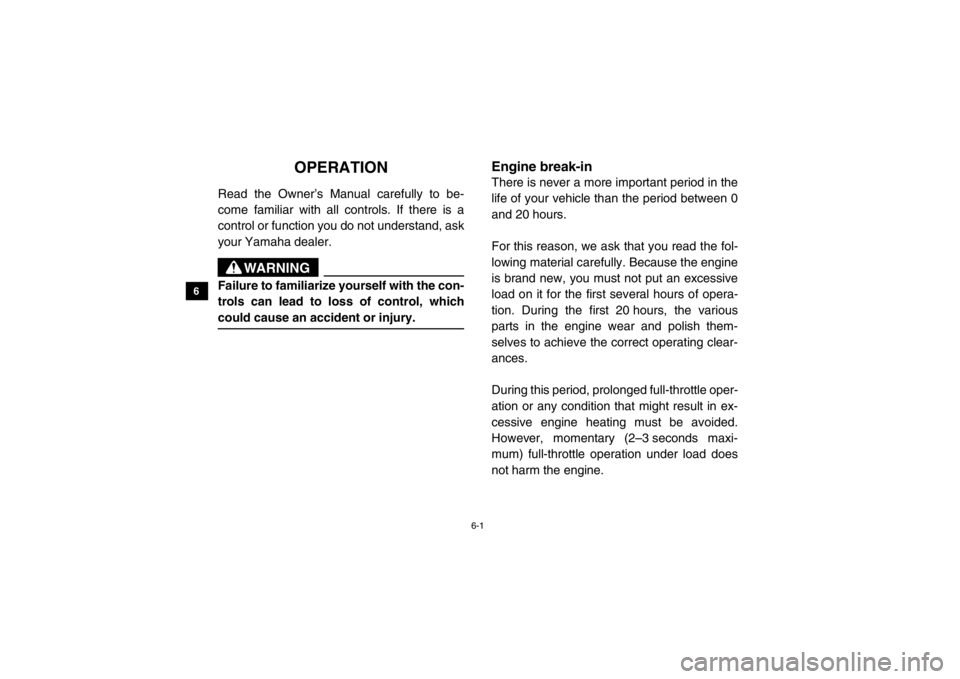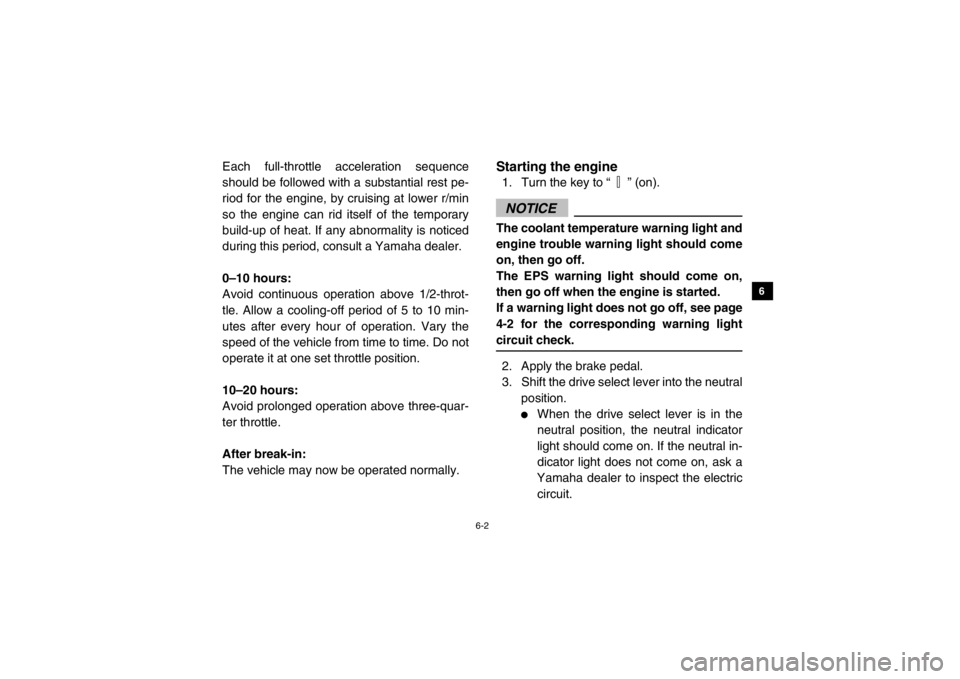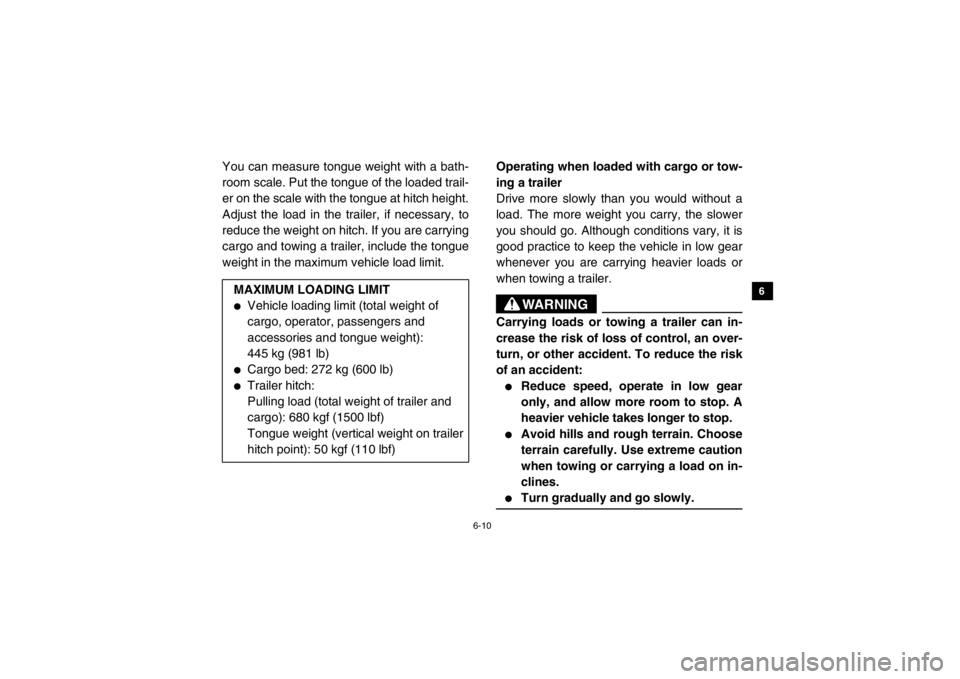Page 67 of 180
5-5
1
2
3
45
6
7
8
9
10
11
12
13
14
Portable fuel containers
If you carry a portable fuel container in the bed
of your Yamaha Viking, be sure to secure it
with the cap tightened before driving the vehi-
cle.
Always place a portable fuel container on the
ground before filling it. Before removing the
container cap, touch the container with the
fuel dispenser nozzle. Keep fuel dispenser
nozzle in contact with container inlet when fill-
ing. WARNING! Never refill a fuel container
in the bed of any vehicle. Fire may result
from a build-up of static electricity. The
discharge of this build-up while refueling
can cause a spark and ignite the gasoline.
Recommended fuel:
Regular unleaded gasoline only
For Europe:
Regular unleaded gasoline only with a re-
search octane number of 95 or higher
Fuel tank capacity: 36.7 L (9.70 US gal, 8.07 Imp.gal)
1XP7B_EE.book Page 5 Tuesday, February 4, 2014 3:40 PM
Page 70 of 180

5-8
5
6
7
8
9
10
11
12
13
14
A crash can damage the restraint systems in
your vehicle. A damaged restraint system
may not properly protect the person using it,
resulting in serious injury or death in a crash.
To help make sure your restraint systems are
working properly after a crash, have them in-
spected and any necessary replacements
made as soon as possible.Passenger handholdCheck that the handhold bar and its supports
are in good condition. Confirm that the locking
pins are securely fastened, and then push
and pull on the handhold to make sure that it
is not loose.EVU01230SteeringPark on level ground. Turn the steering wheel
right and left. Check for excessive free play,
abnormal noises, or a rough feeling. Have a
Yamaha dealer repair as necessary for proper operation.
EVU00470Fittings and fastenersAlways check the tightness of chassis fittings
and fasteners before a ride. Take the vehicle
to a Yamaha dealer or refer to the Service
Manual for correct tightening torque.Instruments, lights and switchesCheck that all instruments, lights and switches
are working properly. Correct if necessary.Control cablesWhen riding in cold weather, always make
sure all control cables work smoothly before
you begin riding. WARNING! Control cables
can freeze in cold weather and you could
be unable to control the vehicle.EVU00500TiresCheck tire pressure regularly to make sure it
is at the recommended specifications. Also
check for wear and damage.
1XP7B_EE.book Page 8 Tuesday, February 4, 2014 3:40 PM
Page 71 of 180
5-9
1
2
3
45
6
7
8
9
10
11
12
13
14
EVU00510Tire pressure
Use the tire pressure gauges to check and ad-
just tire pressures when the tires are cold. Tire
pressures must be equal on both sides.
WARNING! Operation of this vehicle with
improper tire pressure may cause severe
injury or death from loss of control or roll-
over. Tire pressure below the minimum
specified could also cause the tire to dis-
lodge from the rim under severe riding
conditions.
Set tire pressures to the following specifica-
tions:Recommended tire pressure:
Vehicle load:
0 – 300 kg (0 – 661 lb)Front:75 kPa (0.75 kgf/cm
2, 11 psi)
Rear: 90 kPa (0.90 kgf/cm2, 13 psi)
Vehicle load:
300 kg – maximum
(661 lb – maximum)Front:
75 kPa (0.75 kgf/cm2, 11 psi)
Rear: 125 kPa (1.25 kgf/cm2, 18 psi)
1XP7B_EE.book Page 9 Tuesday, February 4, 2014 3:40 PM
Page 74 of 180

6-1
6
7
8
9
10
11
12
13
14
EVU00530
1-OPERATION
Read the Owner’s Manual carefully to be-
come familiar with all controls. If there is a
control or function you do not understand, ask
your Yamaha dealer.
WARNING
Failure to familiarize yourself with the con-
trols can lead to loss of control, which
could cause an accident or injury.
Engine break-inThere is never a more important period in the
life of your vehicle than the period between 0
and 20 hours.
For this reason, we ask that you read the fol-
lowing material carefully. Because the engine
is brand new, you must not put an excessive
load on it for the first several hours of opera-
tion. During the first 20 hours, the various
parts in the engine wear and polish them-
selves to achieve the correct operating clear-
ances.
During this period, prolonged full-throttle oper-
ation or any condition that might result in ex-
cessive engine heating must be avoided.
However, momentary (2–3 seconds maxi-
mum) full-throttle operation under load does
not harm the engine.
1XP7B_EE.book Page 1 Tuesday, February 4, 2014 3:40 PM
Page 75 of 180

6-2
1
2
3
4
56
7
8
9
10
11
12
13
14
Each full-throttle acceleration sequence
should be followed with a substantial rest pe-
riod for the engine, by cruising at lower r/min
so the engine can rid itself of the temporary
build-up of heat. If any abnormality is noticed
during this period, consult a Yamaha dealer.
0–10 hours:
Avoid continuous operation above 1/2-throt-
tle. Allow a cooling-off period of 5 to 10 min-
utes after every hour of operation. Vary the
speed of the vehicle from time to time. Do not
operate it at one set throttle position.
10–20 hours:
Avoid prolonged operation above three-quar-
ter throttle.
After break-in:
The vehicle may now be operated normally.
5B410007Starting the engine1. Turn the key to “ ” (on).NOTICEThe coolant temperature warning light and
engine trouble warning light should come
on, then go off.
The EPS warning light should come on,
then go off when the engine is started.
If a warning light does not go off, see page
4-2 for the corresponding warning light
circuit check.2. Apply the brake pedal.
3. Shift the drive select lever into the neutralposition.
●
When the drive select lever is in the
neutral position, the neutral indicator
light should come on. If the neutral in-
dicator light does not come on, ask a
Yamaha dealer to inspect the electric circuit.
1XP7B_EE.book Page 2 Tuesday, February 4, 2014 3:40 PM
Page 78 of 180

6-5
6
7
8
9
10
11
12
13
14
Shifting: neutral to reverse
WARNING
Before you shift into reverse, make sure
there are no obstacles or people behind
you. When it is safe to proceed, go slowly.
Hitting an obstacle or person could result
in serious injury or death.1. Stop the vehicle, take your foot off the ac- celerator pedal, and check behind you.
2. Apply the brake pedal.
3. Shift from neutral to reverse or vice versa
by moving the drive select lever along the
shift guide.
●
When in reverse, the reverse indicator
light should be on. If the light does not
come on, ask a Yamaha dealer to in-
spect the reverse indicator light elec-
trical circuit.
●
Due to the synchronizing mechanism
in the engine, the light may not come
on until the vehicle starts moving.
1. Drive select lever 2. L (Low-range)
3. H (High-range) 4. N (Neutral)
5. R (Reverse)4. Release the parking brake, if applied.
5. Check behind the vehicle for people or obstacles, and then release the brake
pedal.
6. Press the accelerator pedal gradually and continue to watch to the rear while
backing.
1
2
5 4
3
1XP7B_EE.book Page 5 Tuesday, February 4, 2014 3:40 PM
Page 82 of 180

6-9
6
7
8
9
10
11
12
13
14
Prepare your load or trailer
WARNING
Improper loading or towing can increase
the risk of loss of control, an overturn, or
other accident:●
Do not exceed the Maximum Loading
Limits for the vehicle (see page 6-10
and vehicle labeling).
●
Keep weight in the cargo bed centered
side to side, and as low and as far for-
ward as possible. Top-heavy loads in-
crease the risk of overturn. Be sure
cargo is secured – a loose load could
change handling unexpectedly or
strike occupants.
●
Do not exceed the maximum tongue
weight.
●
Make sure the load does not interfere
with your control or ability to see
where you are going.
●
Tie down cargo in the trailer securely.
Make sure cargo in the trailer cannot
move around. A shifting load can
cause an accident.
Use the hooks equipped on the cargo bed to
tie down loads.
Choose a trailer hitch drawbar designed for
use with a 5 cm (2 in) receiver. (See page
4-28 for more information.)
1XP7B_EE.book Page 9 Tuesday, February 4, 2014 3:40 PM
Page 83 of 180

6-10
1
2
3
4
56
7
8
9
10
11
12
13
14
You can measure tongue weight with a bath-
room scale. Put the tongue of the loaded trail-
er on the scale with the tongue at hitch height.
Adjust the load in the trailer, if necessary, to
reduce the weight on hitch. If you are carrying
cargo and towing a trailer, include the tongue
weight in the maximum vehicle load limit.Operating when loaded with cargo or tow-
ing a trailer
Drive more slowly than you would without a
load. The more weight you carry, the slower
you should go. Although conditions vary, it is
good practice to keep the vehicle in low gear
whenever you are carrying heavier loads or
when towing a trailer.
WARNING
Carrying loads or towing a trailer can in-
crease the risk of loss of control, an over-
turn, or other accident. To reduce the risk
of an accident:●
Reduce speed, operate in low gear
only, and allow more room to stop. A
heavier vehicle takes longer to stop.
●
Avoid hills and rough terrain. Choose
terrain carefully. Use extreme caution
when towing or carrying a load on in-
clines.
●
Turn gradually and go slowly.
MAXIMUM LOADING LIMIT●
Vehicle loading limit (total weight of
cargo, operator, passengers and
accessories and tongue weight):
445 kg (981 lb)
●
Cargo bed: 272 kg (600 lb)
●
Trailer hitch:
Pulling load (total weight of trailer and
cargo): 680 kgf (1500 lbf)
Tongue weight (vertical weight on trailer
hitch point): 50 kgf (110 lbf)
1XP7B_EE.book Page 10 Tuesday, February 4, 2014 3:40 PM